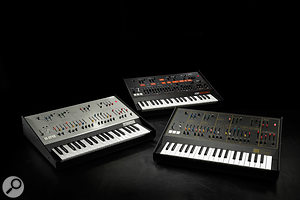So we were at Korg's NAMM press event today and got a look at the new ARP Odyssey and the updated Korg Kronos. But these aren't the only new products to come from the Japanese giant at NAMM.
Notably, Korg have also introduced the MS-20M Kit — an MS-20 module available in kit form along with the SQ-1, a portable sequencer.
 Korg have been playing with the MS-20 format for a couple of years, with 2013 seeing the introduction of the MS-20 mini, and the MS-20 Kit coming out in 2014.
Korg have been playing with the MS-20 format for a couple of years, with 2013 seeing the introduction of the MS-20 mini, and the MS-20 Kit coming out in 2014.
Incredibly, both of these were designed by the engineers who developed the original MS-20 in 1978. At its introduction, the designers of the MS-20 wanted to create an interesting product quickly; the result was an enormous hit, but the designers felt there were actually a few things left undone. Now, after 37 years, the user-assembled MS-20M Kit has been completed. The MS-20M Kit is based on the MS-20 with additional improvements; it's an analogue synthesizer module where you can choose your preferences and assemble yourself. In addition to enhanced synthesis possibilities provided by oscillator sync, FM, two filters (pre and post), and PWM, there are jacks such as a CV IN that supports both Hz/V and V/Oct, making it play nicely with other equipment. And, with the inclusion of the SQ-1 step sequencer, you can also create and play sequences.
When the classic MS-20 synth appeared in 1978, it had a trusted partner in the SQ-10 step sequencer. Now, after thirty years, the SQ-10 has evolved into the more modern SQ-1.
The SQ-1 is a compact step sequencer with 2 x 8 steps. Its wealth of connection jacks allows it to be connected to the MS-20 and a variety of other synthesizers. Vintage analogue synths or the latest compact synths can be controlled from this single unit. You can also switch between a variety of synthesizer modes and use the step buttons to create performances overflowing with spontaneity, just as when using a Volca unit.
There's no numerically-bound parameter editing here, typical of a DAW. Given the success of the Volca boxes, that's probably a good thing. It also inherits 'Step edit' buttons inherited from the Volca, providing further improvisatory possibilities.
As a connector, the SQ-1 provides two CV/GATE OUT channels, the standard MIDI OUT and USB MIDI, littleBits out (to connect to the littleBits synth kit by littleBits Electronics Inc.), plus the SYNC IN/OUT channel that allows you to connect to the Volca series and Monotribe.
It is set to retail for around £95.
 We'll be getting some audio demos of the ARP Odyssey at the show this week but, in the meantime, here's some more info about it:
We'll be getting some audio demos of the ARP Odyssey at the show this week but, in the meantime, here's some more info about it:
The original ARP Odyssey was a 2 VCO duo-phonic instrument. Its most distinctive feature was its sharp, penetrating sound and its rich range of tonal variation. With a variety of functions and modulation possibilities provided by oscillator sync, sample & hold, pulse width modulation, high-pass filter, two types of envelope generator, and pitch bend using the PPC, it was able to create a wide range of sounds.
The ARP Odyssey reproduces the sounds of these components at the circuit level. Under the supervision of David Friend — a founder of ARP — parts were carefully selected and every detail was adjusted to replicate the original unit's distinctive synthesis.
Broadly speaking, there were three versions of the original ARP Odyssey, divided by the date of production, with the major difference being the filter circuit. The ARP Odyssey provides all three of these different filter circuits, and allows you to select them with a single switch.
TYPE I (Rev1) is a 12 dB/Oct circuit that produces a sharp, punchy sound. TYPE II (Rev2) is a 24 dB/Oct filter with better-sounding lows. TYPE III (Rev3) maintains stability even when the resonance is raised. These distinctive filters have been reproduced just as they originally were.
The look of the Odyssey also changed over time and there are now three different versions available. Each with slightly different cosmetics, but housing the same synth. There's the regular ARP Odyssey, which should retail for £934, the Odyssey 1 (Mk1 Limited edition) and the Odyssey 2 (Mk2 Limited edition), both of which will cost £982.
On the original ARP Odyssey, the behaviour of portamento when using the transpose function differed between Rev1 and Rev2/3. The ARP Odyssey reproduces both of these behaviours and lets you select the desired one with a switch.
The ARP Odyssey is 14% smaller than the original, too. This seems to be because the keyboard is based around Korg's slightly smaller keybed. Another change is the addition of a 'Drive' switch that is designed to deliver a more powerful analogue sound, distorting the VCA.
The connectors provided on the original ARP Odyssey differed by production date, but based on Rev3 of the original, the ARP Odyssey brings the specifications up to a modern standard. In addition to a MIDI IN connector and USB-MIDI port, Korg have added a headphone jack with adjustable volume. The XLR output jacks which had been unbalanced have been changed to noise-resistant balanced outputs.
Quarter-inch and mini-size patch cables are included. If you connect a patch cable from the newly added headphone jack to the external audio input jack, you can produce a powerful sound by applying self-feedback. If you connect the GATE OUT jack to the TRIG IN jack, the EG won't be retriggered, allowing you to play legato.
The whole instrument comes with a semi-hard case for transport and storage, too.
